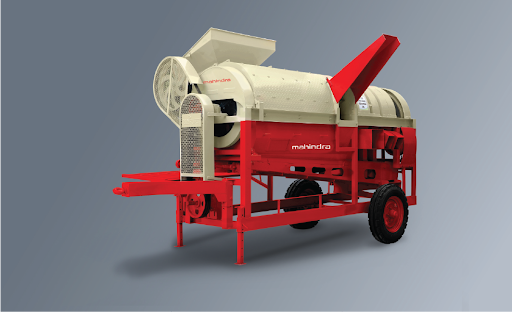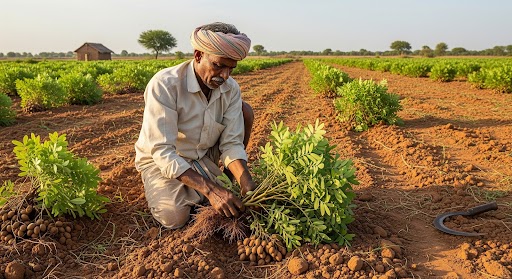Quick Support
Sales
- +91 8888200022 / +91 7744911119
Service
- +91 8888044448
Email
- [email protected]
Imagine harvesting a field of groundnut pods by hand, and then having to separate thousands of pods from their shells, chaff, debris, and dirt. It’s backbreaking work, slow, and prone to heavy losses. But what if that process happens in minutes with minimal damage and maximum efficiency? Enter the world of groundnut threshers: machines designed to do the job fast, cleanly, and reliably. In this article, we explore key features of groundnut threshers, how they work, and how to pick the right one. We’ll also look at the top groundnut thresher machine manufacturers in India and see how Mahindra Farm Machinery complements this ecosystem.

The question “What is the use of a groundnut thresher?” is central for any farmer considering adopting mechanisation. A groundnut thresher machine separates the pods from the plant, discards unwanted materials (stems, dirt, husks), and provides clean kernels ready for further processing or sale.
Key benefits include:
In India, post-harvest losses for many crops average between 5–15 %, depending on handling. Using modern threshers helps reduce this. (While specific data for groundnut may vary, it’s well known that mechanisation reduces losses substantially.)
To choose a good groundnut thresher, understanding its parts and what features matter is important. Below are core components and desired features:
1. Frame and Casing
A robust frame of mild steel or angle iron to support all moving parts and endure field vibrations.
2. Feeding Mechanism
Includes a hopper or belt or side feeder that uniformly feeds pods into the drum without jamming.
3. Threshing Drum / Rotor
The rotating element (spike tooth or stud type) which strikes the pods and separates kernels. Drum speed, diameter, and tooth design are critical.
4. Concave / Sieve & Grates
These allow the separated kernels to pass through while retaining larger debris. Having exchangeable concaves or adjustable gaps is a plus.
5. Blower / Air System
Blower or fan helps blow away lighter chaff and dust, improving cleaning efficiency.
6. Separation & Cleaning Section
Multiple sieves, vibration or shaking systems, and aspirators ensure only clean kernels emerge.
7. Discharge and Collection
Clean kernels and waste exit through separate chutes. Ease of collection matters.
8. Power & Drive System
Tractor-mounted via PTO (often needing 30–40 HP), or electric motor drive for smaller models.
Key Features to Look For:
For example, KS Agrotech’s multicrop groundnut thresher claims a cleaning efficiency of 99.3 % and broken grain of only 0.30 %. (KS AGROTECH PVT. LTD)
Here’s a typical workflow of a groundnut thresher:
1. Feeding
Pods (with minimal sticks or large stems) are loaded into the hopper or side-feeder.
2. Threshing Action
The rotating drum (with spikes) shreds or impacts the pods, loosening kernels from their shells.
3. Separation
The now-loose kernels and shells move into the concave/sieve region. Smaller kernels fall through; larger materials remain above.
4. Air / Blower Cleaning
A blower removes lighter chaff, dust, and empty shells.
5. Vibrating Sieves / Cleaning Systems
Further cleaning to remove fine dust and broken shells.
6. Collection / Discharge
Clean kernels exit via a chute; waste materials go to a separate outlet.
Depending on the model, some machines can throttle certain steps (vary speed, fan power) to suit crop moisture, size, or mixed species.
Two common forms: tractor-mounted (PTO drive) and stationary motor-driven. Tractor-mounted is popular for field use; stationary is useful in centralised processing setups.
When selecting among these, check dealer network, after-sales, spares, and local support.
Mahindra Farm Machinery (part of the Mahindra group) covers a wide swath of implements and post-harvest equipment beyond tractors.
One notable product is the Mahindra Basket Thresher P-990, which handles multiple crops (paddy, wheat, gram, soybean, peas), combining durability and low grain loss.
While Mahindra’s primary thresher offerings emphasise cereals and multi-crop operations, these machines complement groundnut production by enabling integrated mechanised workflows. Many farmers who use Mahindra tractors for cultivation (e.g. in Maharashtra groundnut belts) can seamlessly attach Mahindra’s post-harvest implements.
Moreover, Mahindra’s strong dealer and service network means support and spare parts for attached implements are more accessible to farmers across India.
Here are guidelines to help you decide:
If you already own a Mahindra tractor, pairing it with compatible implements (from Mahindra Farm Machinery or OEMs with good support) is a logical choice.
To ensure long life and consistent performance:
Well-maintained machines reduce downtime and costly repairs.

A groundnut farmer in Maharashtra used a Mahindra tractor for cultivation and attached a multicrop thresher during the season. The farm processed 3–4 acres of pods in a single day instead of taking 5–7 days manually. Kernel damage dropped from 8 % to under 2 %. The availability of Mahindra’s district service centre meant spare parts like belts and sieves were easily replaced.
Groundnut thresher machines bring speed, value, and precision to what was once a labour-intensive, loss-prone process. Knowing how they work and what features matter helps you pick the right machine. And when you pair these with Mahindra’s robust tractor and farm machinery network, you get a fully integrated mechanised solution.
If you’re a farmer in India, consider contacting Mahindra Farm Machinery or a local dealer to explore compatible thresher options or bundle offers. Take the first step toward more efficient groundnut harvesting today.